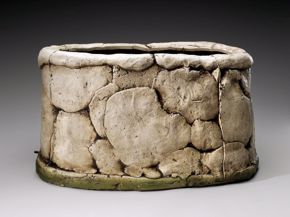A Conservation Challenge: The Ceramic Robotics of Clayton Bailey February 19, 2014

Clayton Bailey, Monster (“Burping Bowl”), 1977, ceramic, the Museum of Fine Arts, Houston, the Leatrice S. and Melvin B. Eagle Collection, Museum purchase funded by the Caroline Wiess Law Accessions Endowment Fund. © Clayton Bailey
Interior of the head after cleaning.
Interior of the head before cleaning, showing the original silicone caulk and the cement fill in the center to balance the head, creating the right equilibrium to produce the burp.
Clayton Bailey, Monster (“Burping Bowl”), 1977, ceramic, the Museum of Fine Arts, Houston, the Leatrice S. and Melvin B. Eagle Collection, Museum purchase funded by the Caroline Wiess Law Accessions Endowment Fund. © Clayton Bailey
Clayton Bailey, Monster (“Burping Bowl”), 1977, ceramic, the Museum of Fine Arts, Houston, the Leatrice S. and Melvin B. Eagle Collection, Museum purchase funded by the Caroline Wiess Law Accessions Endowment Fund. © Clayton Bailey
California artist Clayton Bailey (born 1939) has devoted his career to comedy, science, and pseudoscience through the medium of ceramics. His 1977 work Monster (“Burping Bowl”), on view in Beyond Craft: Decorative Arts from the Leatrice S. and Melvin B. Eagle Collection, is a cross between a pond-dwelling sci-fi monster and the childhood nightmare of someone living in the toilet bowl. A head rests in a bowl of water, and air is pumped under the cavity of the head by an aquarium air pump. When enough air builds up, the head lifts up in the water and releases the air with a burp.
When the object came into the Museum’s collection, it had been separated from its original pump, and where the water level should be was unclear. The short piece of plastic-covered steel wire used as a hinge to affix the head in the bowl was significantly corroded and deteriorated.

Interior of the head before cleaning, showing the original silicone caulk and the cement fill in the center to balance the head, creating the right equilibrium to produce the burp.
After cleaning, we purchased a new pump and a new piece of copper electrical wire for a hinge, and we assembled the object. Experimentation revealed that a variety of sound patterns could be produced, largely dependent upon water level.
When the water level was higher, the burp was louder and longer, and the intervals between burps longer. Lower water levels produced burps smaller and more frequent, with a sound more akin to a burbling fountain, as you can hear here:
Given the artist’s predilection for objects eliciting shock and amusement, the higher water level was more likely to be his preference. However, larger burps produced a larger radius of spray, which would constitute a slipping hazard for Museum visitors. We decided on a middle ground of moderate burps and minimal spray for display:
Want to see more up-close looks at conservation projects? See Selected Case Studies for a few highlights.






